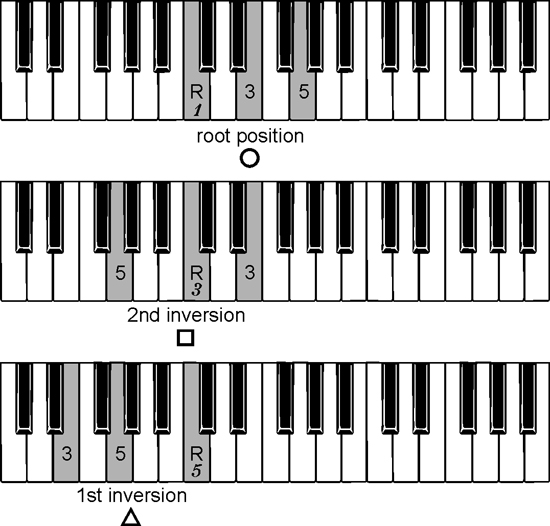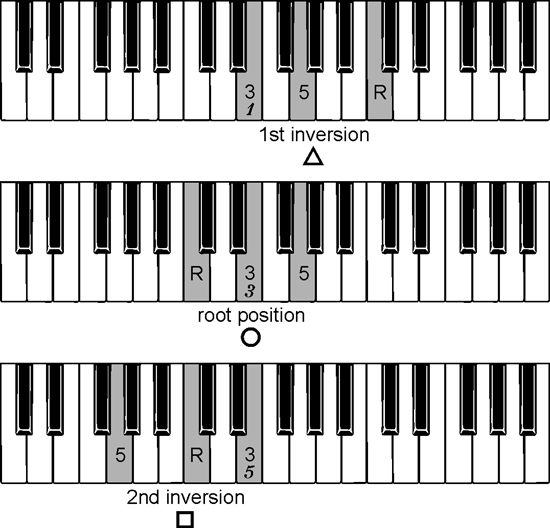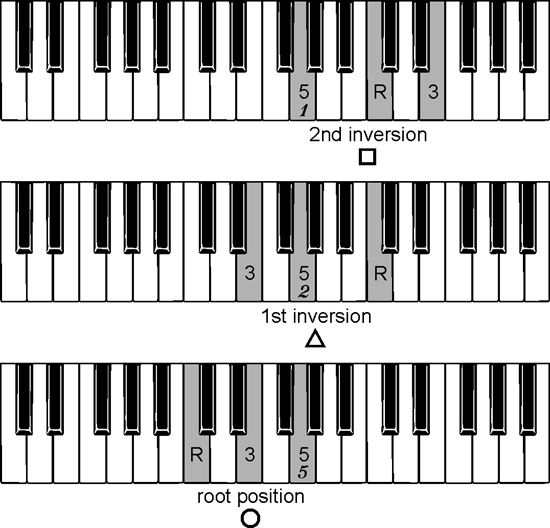Patreon CHORDS 101 Series
Finding the Inversions
- Page Three -
Finding the inversions you need quickly takes practice. The Musicarta Finding Inversions series offers tried and tested methods that definitely help.
This page assumes you have worked through the Finding Inversions series from Page One. If you are coming back after a break, a few minutes revising the series will be beneficial.
This module's exercise will really make your brain work - but thirty minutes spent on it will be worth weeks of purely mechanical practice.
Work at this exercise at least until you understand it in principle - then take a break, and use it as necessary to really get a handle on confusing chords.
|
Inversions series nav |
Three Chord Tones in Three Places
Here are our three starting propositions.
- There are three chord tones – the root, third and fifth of a major or minor scale.
- The chord they make can appear in three different inversions - one of which is called the root position.
- So each chord tone can be the bottom, middle or top note of a triad, and practicing this builds a very solid understanding of inversions.
Try the original audio version of this page for the retro feel, or jump down for the video version.
The exercise
Here are the chord tones of C major shown on a keyboard and marked R (root), 3 (third) and 5 (fifth). Match the performance in the audio file using both hands and any fingers to find the notes.
Name the root, third or fifth as you play them.

The root (R) as the fixed tone
You are going to play the root (R) as the bottom, middle and top note of a triad in turn, reversing through the series until you're back in root position.
Observe that there are two styles of number/letter on these keyboard diagrams.
One sort (numbers 3 and 5) is aligned with the letter 'R' (the root of the chord) and denote the the third and the fifth chord tones.
The other (single) number is a bold italic number, the style usually used in printed music for the fingering. You put the finger shown on the root (R), and find the other two chord tones.
Have a look at the illustration, then copy the audio file.

You will end up back in root position.
The third (3) as the fixed tone
Use your preferred method to go up one inversion into the first inversion.
You will be playing the first inversion chord with fingers 1, 2 and 5.
Now play the third (3) as the bottom, middle and top note of a triad. The key with the fingering number is the note you play first, every time. Follow the audio file.

The fifth (5) as the fixed tone
Climb up one more time, into second inversion.
Then play the fifth as the bottom, middle and then top note of three inversions. Use the fingering given and follow the audio file for guidance.

Build up speed and fluency
Go back to the first group of three chords, focusing on the root. Copy the next audio file – it cycles through the three positions, both up and down, in rhythm.
Practice until you can keep up with the audio performance file below the diagram.

Do the same with the second group of chords, focusing on the third.

Do the same with the third group of chords, focusing on the fifth.

To finish musically, repeat the first group of chords at the octave.
That completes the exercise.
Procedure in C - video
Here's a video demonstration of this procedure. Use it to cement your understanding. Keep practicing until you can play the procedure in C fluently.
Work through any confusion until you can play at this speed.
Make sure you are using the 'official' fingering for the inversions - 1, 3, and 5 for the root position (circle symbol) and second inversion (square) chords, and 1, 2, 5 for the first inversion (triangle) chord.
(The 1, 2, 5 fingering for the first inversion chord keeps the back of the hand flat. Using 1, 3, 5 for this chord tips it over to the little finger side. That's why you should work hard on getting it right.)
Whenever you are learning a new chord from the Musicarta Keyboard Chord Generator, use this exercise and you will soon know your chord very well.
A pdf file of the written-out music for the complete exercise is available here, but playing without the music and concentrating on 'seeing the chords in the keyboard' will do you much more good in the long run!
Now go on to play the exercise in D and B flat majors.
|
Inversions series nav |
Hope you're enjoying studying with Musicarta! Come back soon!
|
OUT NOW! |
THE MUSICARTA BEAT & RHYTHM WORKBOOK At last! An effective approach to keyboard rhythm & syncopation skills. Learn more! |
ONLY $24.95! |
PATREON |
The MusicartaA methodical approach to keyboard syncopation for
|
PUBLICATIONS
exciting keyboard
creativity courses
CHORDS 101
WORKBOOK

~HANON~
video course

Musicarta
Patreon
PENTATONICS
WORKBOOK
video course

Creative Keyboard
video course

BEAT AND RHYTHM
WORKBOOK

- Volume 1 -

12-BAR PIANO
STYLES WORKBOOK

MUSICARTA MODES
WORKBOOK

PIANO STYLE

CANON PROJECT
video course

VARIATIONS
video course


- Piano Solo -
video course

- Piano Solo -


YouTube playlists